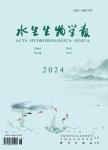GENETIC DIVERSITY OF FIVE FRESHWATER MUSSELS IN GENUS ANODONTA (MOLLUSCA: BIVALVIA) REVEALED BY RAPD ANALYSIS
GENETIC DIVERSITY OF FIVE FRESHWATER MUSSELS IN GENUS ANODONTA (MOLLUSCA: BIVALVIA) REVEALED BY RAPD ANALYSIS作者机构:College of Fisheries Huazhong Agricultural University Wuhan 430070
出 版 物:《水生生物学报》 (Acta Hydrobiologica Sinica)
年 卷 期:2006年第30卷第6期
页 面:684-691页
核心收录:
基 金:the Special Project Foundation (Grant No.2000050406) of Doctoral Degree Ministry of Education andthe Natural Science Foundation(Grant No.99J104) of Hubei Province P. R.China
主 题:Genus Anodonta Chinese unionidae Genetic diversity RAPD analysis
摘 要:Unionidae are an important group of benthic freshwater species. Due to the convergence phenomenon within freshwater mussels, there is still much controversy in the classification of Chinese Unionidae. In China, most studies on freshwater mussels emphasized resource investigation, biology and morphology, while little has been done in genetics, and particularly not in population genetic structure as well as genetic diversity. In order to further understand the status of genetic diversity of different species, random amplified polymorphic DNA (RAPD) markers were used to detect genetic diversity of populations in five species of the genus Anodonta: Anodonta arcaeformis, A. arcaeformis flavotincta, A. fluminea, A. woodiana woodiana and A. ***. DNA extraction method was based on phenol-chloroform and extracted genomic DNA from the adductor muscle and mantle tissues. Sixteen random primers were used for RAPD amplification and the polymorphism of amplified loci were analyzed. The results demonstrated that the percentage of amplified polymorphic loci for various populations ranged from 34.5% to 62.8%, the mean Shannon’s genetic diversity indices ranged from 0.2021 to 0.3552, and the mean intra-population Nei’s genetic distance ranged from 0.1386 to 0.1713. In all populations of the five species, the genetic diversity for A. arcaeformis was the largest, and that of A. fluminea was the lowest. The inter-population genetic distance between A. w. woodiana and A. w. pacifica was 0.3186, so they can be considered as two sister species at the genetic angle.



